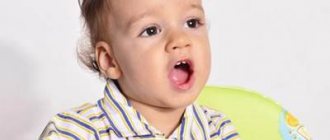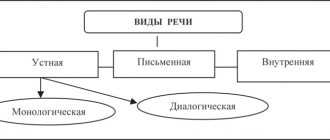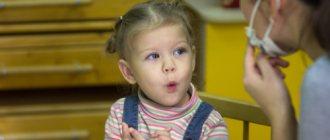Features of speech development at an early age: passive and active speech.
How often, when we talk about early childhood, we have to repeat the words “first”, “for the first time”. The first steps, the first attempts to do something on your own, the first words. With what impatience parents wait for the child’s first word, how they rejoice at it.
When does a child start talking? As a rule, this happens in the second half of the second year, although the baby begins to pronounce the first words already at the end of the first - beginning of the second year. Mastering active speech often has the character of an “explosion” - just yesterday the child was silent and suddenly began to speak in such a way that it is impossible to stop. Psychologists associate this sudden occurrence of active speech with the child’s discovery of the fact that every object has its own name. Endless questions “what is this?” and the same endless naming of various objects actually reflects the baby’s special interest in the world of things and in their verbal designation.
Speech develops in two directions. Initially, the formation of so-called passive speech occurs: the baby begins to understand speech addressed to him, but does not yet know how to speak. Passive speech occurs already in infancy. So, in the seventh or eighth month of life, a child can understand many words. The mother asks the baby: “Where is the clock?”, and he looks for the alarm clock with his eyes and fixes his gaze on it; “Where is the ball?” - and the baby points his finger at him and reaches out to him. By the end of the first year, children begin to associate words not only with objects, but also with movements. You tell your child “okay-okay” and he starts clapping his hands cheerfully. And if you say “goodbye”, he waves his hand at you.
At an early age, passive speech develops at a very rapid pace. Children of the second year of life show a pronounced interest in the speech of the people around them. At this age, a child well understands the meaning of an adult’s speech addressed to him, knows how to carry out his simple requests and instructions: “Bring me a newspaper,” “Pick up a toy,” etc. A child of this age loves it when people speak directly to him. But he is also attentive to conversations that do not directly relate to him. It happens that the baby is busy with his own business, but if the grandmother says: “I can’t find the glasses,” the grandson takes off, finds the glasses and brings them, although no one asked him for this. Thus, the child not only associates a word with a specific object, but also responds to it with an action, the purpose of which he determines independently.
In addition to the meaning of speech, children are interested in the very combination of sounds, their rhythm, tempo and intonation with which words and phrases are pronounced. The word acquires a special and independent meaning for a child of the second or third year of life, it becomes a special subject that he masters both in its semantic content and in sound. This has long been noticed in folk pedagogy and has led to the creation of a kind of speech music in such jokes and sayings as “magpie-crow”, “horned goat”, etc. The baby does not yet know how to speak, but gladly accepts the adult’s play and listens to the expressive lines of the jokes , carefully looks at the lips of an adult, sometimes tries to repeat the sounds of his speech.
Later, active speech arises - the independent use of words. Up to a certain age, the number of words a child understands significantly exceeds the number of words actively pronounced. And for some children, the period of passive speech is greatly prolonged. A child can, up to two or two and a half years old, understanding everything that adults tell him, correctly fulfilling their requests, not utter a single word, continuing to explain himself to others using babble and gestures. And yet, speech develops due to the expansion of the passive vocabulary and the accumulation of experience of audible speech. It happens that children who are persistently silent until the age of two suddenly begin to speak in sentences immediately and quickly catch up in speech development with their peers who began to speak at the beginning of the second year.
Therefore, you should not be particularly worried if, before the age of two, there are only two or three words in the baby’s active vocabulary. If he understands speech addressed to him, listens to adults with interest and finds objects familiar to him by name, then his speech development is proceeding normally, and the child should soon speak. But how early he starts talking largely depends on the child’s living conditions, which are created by adults.
Many parents, in order for the child to speak more quickly, try to give the child verbal models: “Say - crib, say - spoon.” And to the great joy of adults, some children, already at eight to ten months, begin to clearly repeat certain words, surprising loved ones with their “extraordinary abilities.” For a long time, it was generally accepted that such imitation exercises are the main source of the development of a child’s own active speech. However, observations show that, despite the seemingly impressive simplicity of learning using this method, there is still no direct connection between imitation of words and active speech. Children often willingly repeat words from adults, but do not use them in real life situations. It turns out that teaching the word is not so direct and simple. Of course, imitation is a necessary condition for mastering speech, but still, the ability to imitate in itself does not lead to the active use of words for communication purposes. What needs to be done so that the baby moves from passive understanding of speech and repeating words after adults to his own active speech?
The baby’s first active word is born in his joint games and activities with adults about objects. Let us remember that in the first year of life, especially in the first half, communication between adults and the baby consists mainly of emotional contacts: the exchange of glances, smiles, and gestures. Although adults talk to the child, at this age speech is not yet a necessary means of communication for him, because adults understand without words what the baby needs. After six months, and especially after a year, when the child’s interests begin to expand and he is increasingly attracted to the objects of the surrounding world, emotional contacts become insufficient for communication, which takes the form of objective-practical interaction, to proceed fully and fulfill its developmental function. The child tries to explain something to the adult with the help of gestures, babble, and affective exclamations, but the adult can no longer always understand what the child wants from him. Therefore, at this age, conflicts often arise due to mutual misunderstanding. Now, in order for the interaction between an adult and a child to proceed safely, the baby must not only be able to listen to the adult, but also express his desires in words. Thus, the word must become a means of communication for him.
The emergence of speech as a means of communication is often quite dramatic. If a child wants to get an object, he first resorts to already proven methods of influencing an adult: he reaches for the object and persistently repeats “give, give, yes, yes, yes!” At the same time, the adult’s requests to name the desired object with a word turn out to be completely unsuccessful. The child is only interested in the object itself; he does not seem to hear and does not want to listen to the adult. He does not need communication with him, but a toy. The word spoken by an adult does not evoke any response from the baby. This situation can be described as a “child-object”. It is the child’s refusal to express his desire by naming objects that parents most often complain about. If they insist that the baby still say the right word, the child begins to cry, scream, throw a tantrum, which lasts until the mother or father gives up and gives in to the son or daughter. This stage can last quite a long time.
If adults periodically create a “situation of misunderstanding” in response to the child’s demands, addressed more to the object than to the adult, a moment comes when the child seems to rethink what is happening and switches his attention from the object to the adult. If he cannot get the toy he needs, he begins to look not only at her, but also at his mother, making requests specifically to her using extensive babble and pointing gestures. This situation can be called “child-adult”. In this situation, the adult’s words increase the baby’s attention to him and at the same time stimulate the child’s speech. However, even now the baby still does not name the object with the corresponding word.
And finally, the next stage comes: the baby is distracted from the object that he wants to receive, and begins to carefully look at the lips of the adult, who asks to name the object, and listens to the word that he pronounces. The babbling stops, the child begins to try to pronounce the right word. If he succeeds, he joyfully and repeatedly repeats this word. The word becomes a means of communication. Moreover, very often this word turns into an independent subject of communication. Many parents have probably observed how a child who initially demanded, for example, that he be given a watch to play with, standing high on a shelf, having learned to call it a word, turned this word into a kind of game, endlessly pointing at the watch to mom or dad and happily pronouncing “Tisya, Tisya”, no longer demanding to receive them. Thus, the baby discovers the possibility of verbal play, purely verbal communication.
Only after going through these three stages does the child begin to actively use the word. If any desire of the baby, expressed through non-verbal means, is satisfied, and adults anticipate all his desires without encouraging the child to use speech, its appearance may be delayed for a long time. It should be remembered that the goal of saying something is set for the child by an adult. In order for a child to start talking on his own initiative, he must have a need to communicate with an adult and in some subject. Only communication with an adult about an object or objective actions included in communication create the need to name the object and express one’s desire in words.
What is it, the baby's first word? It seems to many parents that the baby’s first word should mean something most dear to him, needed and loved, for example, “mom” and “dad”. But this does not always happen. Most often, it is generally difficult to “catch” this first word, because it differs little from babbling. But, nevertheless, this is no longer babble, but a word, because it is repeated in the same circumstances and means something specific. But what exactly it is can be difficult to find out. This is due to some features of children's first words, which psychologists call autonomous child speech.
The first feature of autonomous child speech is the special sound composition of the word. A child can pronounce only one syllable of a word, for example, “pa” instead of “fell,” or pronounce the word in full, but distort its sound, for example, “oonya” instead of “raven.” Among the first words there are many onomatopoeic ones, for example, “av-av” (dog), “mu-u” (cow), “tu-tu” (car), etc.
The second feature is the peculiar meaning of children's words. The child's naming of objects is unstable. He calls different objects with the same word. So “kitty-kitty” can refer to both a cat and a fur hat. And vice versa - the child gives different names to the same object. For example, he can once call a toy duck the same as a toy dog, and another time as a teapot, only on the basis that all these objects are yellow. This indicates that the child’s first generalizations are built not on the basis of the essential characteristics of objects, but on random, situational coincidences of their individual qualities.
At this age, the child’s words can have the meaning of an entire sentence or statement. And this meaning may change depending on the situation. Usually such words are accompanied by facial expressions and gestures. Thus, the word “mother” in a situation in which a child, pronouncing this word, reaches out with his hand to the ball, means: “Give me the ball,” and in a situation when he, having hit himself, calls his mother, behind this word there is a complaint: “I it hurts, have pity on me.”
The specificity of children's speech is explained by the peculiarities of the child's thinking at this transitional stage of development. Speech thinking is just beginning to take shape; the child’s thoughts are still dependent on the specific situation that he perceives. The situational nature of a child’s speech and its special sound composition often make it difficult for a child to communicate with others, since the baby’s words are understandable only to those adults who constantly communicate with the child.
After one and a half years, the child’s speech becomes more and more independent, and the pace of its development increases. The vocabulary is growing rapidly; words denoting objects become more stable and unambiguous. In addition to nouns, verbs and some grammatical forms appear in the child’s speech, such as past tense, third person. By the end of the second year, the child forms small sentences of two to three words.
By the end of the child's second year, speech becomes the main means of communication. Relationships with adults are expressed in verbal form. The child turns to those close to him for various reasons: he asks, demands, points out, names, and then informs.
In the third year of life, children's speech activity increases rapidly. Speech is included in almost all aspects of their life. The reasons for a child’s address to an adult through speech become more diverse and more complex. The kid wants to talk about what he did; seeks explanations for the incomprehensible; asks to show how to do something; he can talk in detail about what he saw, come up with his own story, express his desires in words, and share his experiences. The child asks questions about everything he sees around him. The baby is still interested in the external properties of things, but this interest is a step to the next age stage - preschool, the age of “why little children”. It is typical that a child can ask the same question about an object known to him and its name. This fact indicates that he seeks from an adult not only information about the environment, but also encourages him to communicate. He enjoys adult attention and his own ability to ask questions.
By the age of three, a child has a large vocabulary, uses almost all parts of speech, and case and tense appear in it. In the third year, the child mainly masters prepositions and adverbs (over, under, on, next to), some conjunctions (like, because, and, and, when, only, etc.). During this period, the structure of speech becomes more complex. The child begins to use three, four or more word sentences, interrogative and exclamation forms, and over time the child begins to use complex subordinate clauses. The child’s speech is rapidly approaching the speech of an adult, opening up ever greater opportunities for the child’s versatile communication with people around him, including peers.
Despite the presence of certain patterns in the development of speech, the timing of its occurrence, the pace and nature of its formation may be different. The indicated features of speech development in the second and third years of children’s lives are conditionally related to age. Some children pronounce their first words at the end of the first year of life, others only after two years. Some babies are delayed at the stage of pronouncing individual words, others immediately begin to speak in sentences. Some children show themselves to be “verbalists” early on, while others, despite having sufficiently developed speech, grow up “silent.” Genetic factors also contribute to the timing of the appearance of speech. Thus, in a family where one of the parents began to speak late, one can expect a later appearance of active speech in the child. It is also known that girls often begin to speak earlier than boys.
Individual differences in the rate of speech development in children are so great that it is impossible to mechanically, based only on the child’s passport age, assign him to one or another age category and draw conclusions about developmental delays. In the first half of early childhood, the most important indicator of speech development is passive speech.
Briefly about the main thing
- In order for a child to successfully master speech, you need to communicate with him as much as possible, even when he is not yet speaking. An adult is the main source and model of speech for a child.
- The child’s vocabulary is replenished during practical activities. Seeing and holding objects in his hands, using them for their intended purpose, the baby remembers the names and learns to use them correctly in his speech.
- The child’s speech will develop more actively if the parent offers age-appropriate books. At the same time, the plots should be close to reality and describe everyday activities familiar to the child: fairy tales are not recommended for children under 3 years of age.
- Overprotection in upbringing, incorrect pronunciation, high speed of speech, various mistakes and the use of too complex speech patterns by adults prevent a child from learning to speak.
- From 1 to 2 years of age, speech development goes like this: the child begins to separate words in the parent’s speech → observes the adult’s articulation and repeats words after him, gradually doing it better → meaningfully names the objects with which he interacted → recognizes and uses verbs to make statements desires → uses gestures less often and words more often → actively and unnoticed by others replenishes vocabulary → pronounces sentences of two and three words.
- At 2 years of age, the “speech explosion” begins. The child learns with great interest and easily assimilates new words and begins to think in words. Gradually, the words in the sentences become consistent.
- By the age of 3, the baby uses as many words as he understands. Learns to concentrate and listen, to perceive the plots of literary works and adult stories up to 4 sentences long. Assimilates the rules of behavior that the parent talks about.
The article was prepared based on materials from the course Sensitive periods of child development by V. N. Mogileva - candidate of psychological sciences and Montessori teacher AMI
Photo by Olga Goreva
Editor: Camila Klenowitz
Passive form
Active and passive types of speech in psychology are considered inseparable. It is difficult to talk about them briefly, because this is a very broad topic. It is believed that the child first masters passive speech. That is, he first tries to understand the people talking around him. To do this, he listens to them carefully and remembers first small words, and then phrases. This helps him say his first words and develop in this direction. Therefore, passive speech is that which we perceive. But this name is conditional, since many complex processes also occur during listening. We pronounce every word directed at us “to ourselves,” we think about it, although there are no external signs of such activity. But even here there are exceptions, because not everyone listens the same way: some catch every word, while others do not even understand the essence of the conversation. These types of speech in psychology are described as depending on the individual characteristics of a particular person. Some people are excellent at both actively speaking and passively receiving; some have difficulty with these two processes, while for others one of them predominates.
Introduction
The development of speech and thinking is one of the most important sections of early childhood pedagogy, aimed at the mental development of a child who will live in the 21st century. This obliges us to do a lot: we must provide the child with opportunities to master technologies based on the latest achievements of science and designed for developed human intelligence.
Speech performs a wide variety of functions in human life - communication, transmission of the experience accumulated by mankind, regulation of behavior and activity. All functions of speech are dialectically interconnected: they are formed through each other and function (act) in one another.
In order for these functions to appear in a timely manner and be fully implemented, appropriate conditions are necessary. When a child first begins to speak, he often has difficulty using his speech to organize communication. It is simply impossible to convey to him the experience of previous and current generations (in the form of knowledge, skills and abilities) with the help of words, without visual and effective support. As a regulator of the child’s activity, speech also functions very limitedly during this period. In order to fulfill all its functions, speech goes through a complex and long path of development, closely connected with the general mental development of the child - the enrichment of his activity, perception, thinking, imagination, emotional-volitional sphere.
Early age is the most important in the development of all mental processes, especially speech. Speech development is possible only in close connection with an adult, which is extremely important in a preschool setting.
Speech development is one of the central issues of preschool psychology and pedagogy. Various aspects of its development are studied by many scientists, such as A.N. Gvozdev, L.S. Vygotsky, S.N. Karpova, T.N. Ushakova, M.M. Koltsova, V.I. Beltyukov, N.I. Zhinkin, Lisina M.I., Zaporozhets A.V., L.G. Solovyova. E.D. Dmitrieva. E.A.Mironova, A.M.Borodich. E. G. Pilyugina, G. V. Gribanova, A. M. Prikhozhan and others.
It should also be noted that foreign researchers do not ignore this problem. The largest number of works are found in S. Bular, G. Getzer, W. Goldfarb, Bowlby, Spitz, D.O. Hebba, B.M. Fossa.
Speech is a means of understanding others, it is an expression of a person’s mental, emotional and analytical abilities.
The relevance of this problem lies in the fact that early age is the most important in the development of all mental processes in a child, and especially the development of speech. Mastering it rebuilds the processes of perception, memory, thinking, improves all types of children's activities and the “socialization” of the child (in particular, his relationships with adults and other children).
With proper organization of a child’s entire life and activity, speech can become the main means of communication at an early age.
Kinetic speech
At a time when people had not yet learned to speak, kinetic speech was the only means of communication. But now we have preserved only small pieces of such conversation. This is the emotional accompaniment of language, namely gestures. They add expressiveness to everything said and help the speaker set the audience in the right mood. But even in our time, there is a large group of people who use kinetic speech as their main one. These are people who have problems with the hearing and speech apparatus, that is, deaf and mute. They are divided into those who were born with the condition and those who lost the ability to hear and speak due to an accident or illness. But they all speak sign language, and this is the norm for them. This speech is more developed than that of ancient man, and the sign system is more advanced.
Monologue speech
The types of speech in psychology are quite well covered, and one of them is monologue. It differs from a conversational one in that only one person directly participates in it. The rest are passive listeners who simply perceive it, but do not take part. This type of speech is often used by speakers, public figures, or teachers. It is believed that a monologue story is much more difficult than a dialogic conversation, because the speaker must have a number of skills. He must construct his narrative coherently and consistently, clearly explain complex points, and all language norms must be observed. He must also select exactly those means and methods that will be available to a particular audience; he must take into account the psychological mood of the listeners. And, most importantly, you need to be able to control yourself in any situation.
Basic speech forms
Languages that are used all over the world have one basis - speech. It is quite multifaceted and has many forms. But all the main types of speech in psychology are divided into two groups: 1) oral; 2) written. But they are not something opposite to each other, but are closely intertwined. Their main similarity is the sound system they are both based on. Almost all languages, except hieroglyphic ones, consider written speech as a kind of transmission of oral speech. Thus, an analogy can be drawn with music. Any performer, looking at the notes, time after time perceives the melody that the composer wanted to convey, and if there are any changes, they are insignificant. So the reader reproduces the phrase or word that is written on paper, each time voicing an almost identical scale.










